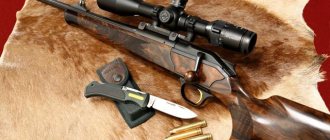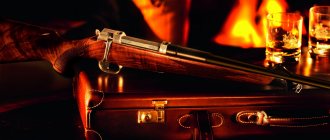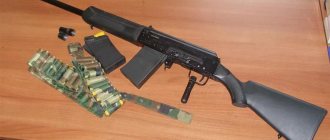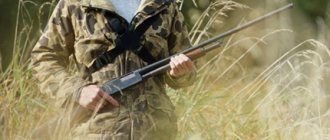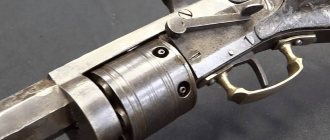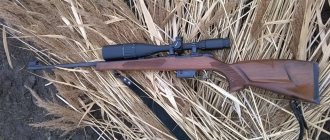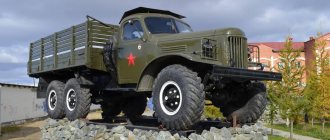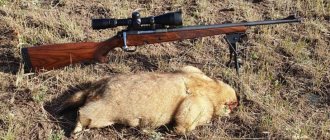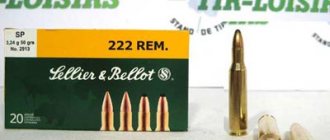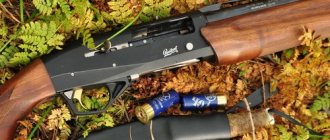There is no more developed, more saturated and more spoiled arms market in the world than the American one. It seemed that the Americans had seen everything possible - and therefore should be very picky when choosing weapons. However, a characteristic feature of overseas hunters, in addition to the desire for quality, is also healthy pragmatism.
For an ordinary resident of the States, a rifle or carbine is not a fetish, but an ordinary tool for hunting. And therefore, a prudent American hunter will never pay more for “just a tool” than he really deserves. And it’s one thing if hunting is a lifelong passion for you, and quite another if it’s just an interesting episode.
In the 2000s. In the USA, the concept of a carbine ready for hunting right out of the box saw the light of day and gained wide popularity. Such carbines with simple optical sights mounted on them were sold in many supermarkets and gun stores and were advertised as the easiest way to get into hunting. It should be noted that the hunting season for white-tailed deer in the United States is quite short, especially for owners of rifles - only a couple of weeks. And if your friends suddenly invite you to go hunting with them, then there simply won’t be time for all sorts of fun with a painful choice, a long purchase and complex preparation. You can’t waste a single extra day, or an extra dollar either - especially if you are not yet sure how much of a hunter you are, and whether a new hobby will “stick” to you. Therefore, such carbines flew off supermarket shelves like hot cakes, especially in the fall - after all, after the hunting season, the Christmas and New Year season immediately begins.
But let's leave America aside for now. Ukraine has its own specifics: for example, the market for hunting weapons in the regions is completely different from the capital, and it is very sensitive, first of all, to price. Finding anything even remotely reminiscent of a modern center-fire rifled hunting weapon for less than 15,000 UAH in domestic gun stores is almost impossible - and this, considering the average Ukrainian salary of about $330, is depressing...
On the other hand, in the neighboring range - 18-20 thousand UAH - there is already a choice, and from several famous American manufacturers at once. This forces many hunters to take a closer look at such offers and think about purchasing their first rifled weapon with an optical sight - primarily for individual hunts. Let's take a closer look at these proposals, because there is no doubt that they arouse the most lively interest.
Savage Axis
Savage Arms dates its history back to 1894, but it introduced its ultra-affordable Axis carbine only in 2011. Since then, the Axis line has grown significantly: in addition to many calibers, there are options in a wooden stock, with a thicker barrel, made of stainless steel, in camouflage colors, etc. Moreover, recently Savage has almost stopped producing simple versions of the Axis and has moved on to the next level - the Axis II model, the main difference of which is the updated stock and the famous Savage AccuTrigger.
Savage Axis II XP: already the second generation of the most popular kit
For the purposes of this article, we are interested in Savage Axis variants equipped from the factory with optical sights (but can also be sold without them) - they are marked by the manufacturer with the letters XP.
In terms of appearance and design, the Axis II XP very well exemplifies the “nothing extra” principle. This is a budget carbine with a longitudinally sliding bolt, made, albeit for the minimum possible money, but in accordance with modern canons of designing such weapons, and not from waste materials. Interestingly, at a very low price, it has such undoubted advantages as a detachable box magazine for four rounds, a grippy fore-end and handle, a very soft perforated butt plate and durable steel swivels for securely attaching the belt.
Savage Axis barrels are made using the mandrel method, which the company considers optimal for all models of its rifles, including more expensive ones. An interesting touch: after burnishing, the trunks undergo a mandatory alignment procedure, and this is done manually!
As in older models, the barrel is attached to the receiver with a thread, and the mirror gap is adjusted here using a barrel nut, which allows this operation to be performed quickly, simply and inexpensively. Other signature features of Savage rifles are also fully present here: a floating bolt face with additional guides, which improves the operation of the bolt group and ensures the contact of the lugs when locking the bolt; a nail extractor located in one of the lugs; two-position slide safety located on the top of the rear of the stock handle - in an obvious and convenient place. And, as already mentioned, in the Axis II models, the very heavy and indistinct trigger of the first Axis was finally replaced by the well-proven AccuTrigger trigger.
The Savage Axis II's safety is more visible and intuitive than the Remington Model 783
If you dig a little deeper, you'll notice some of the ways Savage is keeping this model's cost down relative to its more expensive rifle lines. Axis carbines in all calibers have a long action bolt group - it should be noted that magnum calibers are not available at all in the Axis line. Also noteworthy is the recoil paw, made as a separate part and installed in the stock, and not on the receiver. Finally, the stock itself is made from inexpensive injection molded plastic, and no special measures have been taken to strengthen it; and the steel bushings in the sockets of the stock screws have extremely modest wall thickness. However, all this does not prevent Axis rifles from shooting well if you use them for their intended purpose - for hunting and recreational shooting - and do not ask too much from them.
But what kind of shooting (and especially hunting) can there be without sights? To reduce the cost of production, Savage Arms does not install mechanical sights on carbines, which means they are equipped with an optical or collimator sight. When purchasing the Axis XP kit, the buyer receives a carbine with separate Weaver bases attached to it for mounting optics, as well as a Weaver 3-9×40 optical sight mounted on the rings. These components are manufactured in China and are given to the shooter, as they say, “as change” from the cost of the carbine itself - the price difference between options without optics and with optics is sometimes vanishingly small, if there is any at all. By the way, different Axis models may have different optical sights included: some of them are released under the Bushnell or Kaspa brands. Sometimes (rarely) there are also ballistic reticles, but usually the traditional “duplex” is used.
The buttstocks of both carbines are equipped with soft butt pads: perforated for the Axis, made of Supercell material for the Model 783
Be that as it may, such sights must work as expected, which is guaranteed by both the manufacturer and the seller. Moreover, Savage makes it easier for the novice shooter to install scopes. And although this does not mean at all that it will be permissible not to carry out its hot version, there is hope of at least hitting the target sheet with the first shot. And then, as they say, it’s a matter of technique.
Arthur Savage and his rifle
Over the past almost two centuries, the US shooting community has developed a great love for swing-bolt weapons. American cinema contributed to this to a large extent. Movie characters played by Tom Mix, John Wayne, Tommy Lee Jones and Robert Duvall were armed with similar weapons. Some American citizens went further and called such weapons state-forming, and they really were the distinctive mark of dense hunters and settlers who traveled around the United States in search of a better life. One of the widely used but rarely mentioned rifles of this type was the Savage 99 rock-action rifle, which, although not very recognizable, earned the love of the American shooting community.
Who are you Arthur Savage? Arthur William Savage was a Renaissance man who happened to be born in the age of steam.
Born in Jamaica, he traveled the world and led a very active life. Not feeling satisfied, he tried himself in various matters, from the invention of torpedoes to the study of Australia, where he even had to be captured by the aborigines. He was a railroad engineer and worked on a ranch before getting into gun design. Design
In 1889, Savage, while working for the Utica Railway, patented a hammerless swing-action rifle, which featured a tilting bolt and a rotating magazine. This was a major departure from the bolt-action rifle designs of Winchester, Spencer and other gunsmiths.
Classic bolt-action rifles had a tubular magazine located either under the barrel or in the butt. This imposed certain restrictions on the type of ammunition used, since in order to avoid detonation of cartridges in a tubular magazine, only rimfire cartridges were allowed to be used. The 5-round drum magazine of the Savage 99 rifle allowed the use of modern centerfire cartridges and used a mechanism with a swinging bolt and trigger guard lever. The rifle's magazine was a spring coil with cells to hold cartridges and even had a counter that indicated the number of cartridges. The hammerless design meant that instead of a hammer striker, a percussion mechanism located in the rifle's bolt was used, which provided a higher rate of fire.
Military failure
In 1892, Savage submitted his rifle to military testing in hopes of securing a contract with the military. Today, bolt-action rifles are popular only in the civilian market, while the military and law enforcement agencies view such a design as archaic. However, at the end of the 19th century, the situation was not so clear, and such rifles were the most advanced models of small arms.
The appearance of the Spencer and Henry carbines during the American Civil War had a stunning effect on opponents and aroused fear among them. In addition, Winchester produced swing-action rifles for military customers in Europe and Asia during the second half of the 19th century. Even during the First World War, the Russian tsarist government purchased a significant number of Winchester 1895 swing-action rifles chambered for the 7.62x54 mm cartridge for the needs of the army.
Despite the fact that many military personnel liked Savage’s rifle, preference was finally given to the Craig-Jorgenson repeating rifle. As it turned out during the comparison, the Savage rifle turned out to be lighter and had a higher rate of fire, but it required more time to prepare for shooting, was inconvenient when shooting from a prone position, and, in the opinion of the military, was too complex compared to the Craig-Jorgenson rifle.
Not desperate, Savage modified the design of the rifle and in 1895, he submitted it to the New York National Guard for testing. The modified rifle was accepted and a contract was signed with the designer, which, however, was canceled as a result of some political intrigue. As a result, the New York National Guard was equipped with the single-shot Springfield rifle, with which it fought in the Spanish-American War.
Somewhat more successfully, Savage collaborated with the Guard of Montreal, Canada, which ordered 25 thousand rifles from him. The rifles ordered had a bayonet mount and a stock made in the style of military rifles, and were chambered for the .303 British cartridge.
Commercial success
In 1894, Savage founded his own company and registered his rifle as a civilian rifle in an attempt to promote the rifle into the civilian market. The rifle received a cocking indicator on the top of the tang, which allowed the shooter, even in the dark, to know whether his weapon was ready to fire. Thus the Savage 99 rifle was born.
Savage always tried to grab as much of the market as possible by releasing his rifles in various calibers. Over its more than century-long history, the rifle was produced in at least 18 calibers. From the popular .300 Savage, .30-30 and .243 Winchester to the likes of .38-55 Winchester and .32-40 Ballard. There was even an option chambered for a .410 caliber rifle cartridge. Thanks to this variety of ammunition, the Savage 99 has been used successfully for hunting coyotes and deer as well as elk.
In 1919, the company's logo became an Indian chief with a Savage rifle, which is still the company's calling card today.
Collecting
Over more than a century of production, over a million Savage 99 rifles were produced in various variants. The most common version was the one chambered for the .300 Savage cartridge. This cartridge was subsequently used to create the standard NATO cartridge 7.62x51. Today, rifles manufactured in the 1950s can be purchased for between $300 and $400. Earlier models and in exotic calibers will cost more, often exceeding $1,000. Depending on the quality and style of the rifle, the price can only increase.
Individual Canadian Guardsmen subsequently bought back the rifles with which they served and put their names on the rifles. These rifles are known today as the Savage 99 Musket and the names are typically found on the left side.
In short, if you are a fan of swing-action weapons, then your option would be to purchase the proven Savage 99 rifle.
Remington 783
Now let's take a look at a similar offer from another American giant - Remington Arms, which recently celebrated its 200th anniversary (!). Although most hunters and shooters know Remington Arms for the legendary Model 700, to combat competition in the budget market, the manufacturer offers a rifle and scope kit called the Remington Model 783.
Remington Model 783: budget bestseller from the oldest American manufacturer
This model was first released in 2013, presumably as a response to the Savage Axis. The company pursued a rather aggressive advertising policy, focusing primarily on the high accuracy of fire of these models. This is a little surprising, since for target shooting, where accuracy is truly of fundamental importance, Remington Arms has samples from the upper price range - the Model 700 and Model 40X. However, advertising is advertising, and our job is to carefully consider what is being offered to us for the relatively modest amount of 19 thousand UAH.
Structurally, the 783 model is completely different from the legendary 700 - so much so that upon closer examination it has much more similarities with the already reviewed Savage Axis than with the “seven hundred”. Unexpected, isn't it? But everything becomes clear when you start to look more closely - the fact is that the 783 Remington model is, in fact, a reissue of the Marlin XL7 carbine, which is well known on the budget weapons market. The Freedom Group holding, which includes Remington, bought out Marlin in 2007 and, to strengthen its position in the budget market, decided to produce affordable XL7 models under the Remington brand.
The Weaver 3-9×40 scope (right) on the Savage Axis has a more comfortable eye relief. Both scopes have a 1/4″ click rate and a duplex reticle.
So what do we have? A carbine with a longitudinally sliding bolt and magazine feed, placed in a plastic stock (occasionally there are also variants in wood). If we compare the 783 with the Axis in design, then, to the author’s taste, the Remington’s outline is visually more harmonious. The soft recoil pad is made using SuperCell technology and absorbs recoil well. But the flimsy plastic swivels on the plastic stock are disappointing. But I'm glad to see a steel magazine with a steel latch - Axis's is plastic and can easily break. The magazines are also noticeably different: the Savage has a central feed, which makes equipping such a magazine a little more troublesome; Remington has a checkerboard feed, and it is much easier to equip the magazine. Another thing is that the central feed is considered to work more reliably.
Both carbines have detachable box magazines, with the Axis having a center-feed magazine and the Model 783 having a staggered magazine feed.
The Model 783 box magazine release is steel, the Axis II is plastic.
Noteworthy are the comfortable flat bolt handle, marked with the letter R, and the aesthetically designed bolt shank. The bolt itself is equipped with a floating face with two opposed lugs, like the Axis bolt, but without additional guides. The extractor and ejector are also designed very similarly to the Axis. But what differs is the size of the cartridge case ejection window in the receiver - with Remington it is noticeably smaller. On the one hand, this complicates recharging, on the other hand, it ensures greater rigidity of the receiver.
The Remington Model 783 barrel contour (right) is slightly thicker than the Savage Axis, with an equal length of 56 cm with a rifling pitch of 1:10″
Remington 783 barrels are also mandrelized, screwed into the receiver and secured with a barrel nut. At the same time, the contour of the barrel of the 783 model is slightly thicker than that of the Savage Axis. This is the so-called magnum circuit, and it's definitely done for good reason: the fact is that the Remington 783 is available in both standard calibers and the crushing 7 mm Remington Magnum and .300 Winchester Magnum! However, the balance of the rifle also turns out to be shifted slightly forward, because such a barrel is slightly heavier than usual.
The Remington 783 safety is a standard lever safety, it is located on the right side of the receiver and has two positions. The trigger is called CrossFire, and it also features a center safety plate, giving it a similar appearance to an AccuTrigger. In reality, they work completely differently. If in a hurry you pull the AccuTrigger incorrectly with your finger and it fires, but the central plate is not pressed, then the shot will not fire and the carbine will be disarmed. To return it to combat mode, you need to raise and lower the bolt handle. This will take away several precious seconds, which sometimes cannot be made up.
The design of the Model 783 (left) and Axis bolts is very similar: deep bowl of the bolt mirror, nail extractor in the lug rest, push ejector
Remington's approach in this matter is more logical: until the central plate is squeezed out, you simply cannot pull the trigger, since it does not move back. Accordingly, to shoot you just have to change the position of your finger on the trigger and do everything correctly. This is both faster and clearer for any shooter. If we talk about the trigger force, then for both carbines it turned out to be in the range of 1.6-1.8 kg. And for a novice hunter this is perhaps optimal.
Comparison of Remington Model 783 and Savage Axis II XP stocks (right). Pay attention to the bushings for the stock screws
If you remove the Remington 783 from its stock, you will immediately notice the massive aluminum bushings in the stock screw sockets. Unlike the budget Remington 700 models, the 783 has a free-floating barrel, and the manufacturer talks about pillar bedding - that is, reliable fixation of the receiver in the stock on these same support bushings. Another important point is that in the 783 model the recoil claw is placed on the “hardware” of the rifle and is fixed between the barrel and the receiver. This is a plus, although it makes the design more expensive and complicates assembly.
The optical sight of the Remington 783 kit does not have a name, but its characteristics are the same: variable magnification from 3x to 9x with a front lens with a diameter of 40 mm. In general, such scopes are classic hunting optics and allow you to shoot accurately in a wide variety of hunting situations, so you should not treat them with disdain. Of course, the quality of the picture and mechanics in the sights of both the 783 and Axis are, let’s say, “basic”. However, this will be enough for an accurate shot when hunting in 80% of cases.
Pay attention to the recoil pad: on the Savage Axis it is installed in the stock, on the Remington 783 it is on the barrel
We do not forget, however, that for effective use of any optical sight, you must first set it up and configure it: adjust the distance to the eye and diopter adjustment. This is a separate procedure that is highly advisable to complete before you start shooting.
Weapon carbine Savage
There are not so many specialized types of weapons designed for hunting large ungulates. There are two directions in the design of hunting rifles intended for shooting elk or deer. You can convert a regular shotgun, or you can start right away by creating a special shotgun for shooting slugs. Savage chose the second path to create a specialized 210 model.
Savage 210.
Modern weapons, the Savage 210 carbine, does not even feel like a shotgun. The modernized bolt action is made on the basis of the time-tested Model 110 rifle. It has a synthetic rifle-type stock with a pistol-type neck and swivels for attaching shoulder straps. The Savage 210 looks and feels like a big, imposing weapon that can take on northern giants. Its fully rifled barrel weighs slightly more than a shotgun barrel, which helps keep the weapon steady when shooting handheld.
This 12-gauge carbine weapon, designed for the use of magnum cartridges with a 76 mm sleeve, has a total length of 1140 mm with a barrel length of 597 mm. The Savage 210 comes without sights, with standard finish on the scope mounts. The detachable middle magazine of this box-type weapon with a capacity of two cartridges is somewhat difficult to load. But it has a good trigger, firing cleanly at 4 pounds (about 1.8 kg), which significantly improves the accuracy of this weapon. The recoil of the Savage 12 gauge weapon, which weighs 3.8 kg, can be called tolerable. Moreover, the manufacturer installed a shock-absorbing rubber butt pad on the butt of this model.
The Savage 210 has 1 turn per 35 inch (890 mm) rifling. This ensures optimal combat accuracy when using modern sub-caliber bullets in a BRI-Sabot type container. By the way, BRI-Sabot type bullets are considered one of the best for hunting elk and deer. The accuracy shown by this barrel when using ammunition with such bullets manufactured by Federal and Winchester can be called very good.
However, when using outdated, but more traditional Brenneke-type bullets, the accuracy of the battle is already falling. Firing accuracy when using such ammunition deteriorates, and obvious roundness of the holes appears. If you decide to go hunting with this weapon, follow the manufacturer's recommendations and use the recommended sabot bullets in the containers. Experiments in this case are fraught!
If you plan to hunt in areas where only shotguns are allowed for deer and elk hunting, or expect to only shoot at relatively short distances while hunting, consider the following. The Savage 210 can deliver a precise, fast shot like a rifle; and the heavy, full-bodied impact of a 12-gauge shotgun bullet.
The Savage 210 with a rifled barrel was not designed to fire conventional shotgun loads. But a group of enthusiasts conducted an experiment just for fun. The hunters fired several shots at the target from a distance of 7 yards with cartridges containing No. 7 shot. To everyone's surprise, on the first shot they shot a wide shot, a full 22 inches (558 mm) in diameter! With subsequent shots, we obtained similar results with almost the same type of scree, which is explained by the centrifugal forces that arise when the shot rotates along the rifling in the barrel. If necessary, with such scree when using large-number shot, the Savage 210 carbine can be used as a self-defense weapon when protecting your home.
Savage 210 FT "Master Shot".
Savage Arms is additionally supplying a new development to Russia – the 210 FT “Master Shot” model. This modification, like the basic 210 model, is characterized by the feeling of a powerful, large-caliber carbine. It has a longitudinally sliding rotary bolt of the bolt action type, which locks the barrel by rotating 60 degrees using three lugs. The synthetic stock features the popular Advantage camouflage finish, which camouflages the weapon in any hunting season. The external dimensions of the weapon and barrel length are similar to the main model.
Unlike the main model, the Savage 210 FT carbine has a lighter barrel without rifling, with a 3-inch (76 mm) chamber, equipped with a standard “Winchester” system for installing interchangeable chokes. When sold, the gun is equipped with a “full choke” attachment. It is possible to use attachments: “improved cylinder”, “poluchok”, “choke” and others. The barrel has a bronze hunting-type front sight, and the box has a rear sight with a U-shaped slot. Seats are left on the receiver for mounting an optical sight. The total weight of the weapon is 3.4 kg.
Like most regular Savage rifles, this gun provides solid performance and won't make you regret spending your money once you buy it.
Test shooting
For our test, we chose the Savage Axis II XP and Remington 783 in the most common and popular caliber - .308 Win. The carbines were taken without any selection, before leaving they were re-opened, and the bores of their barrels were cleared of factory lubricant.
We didn’t come up with the expression “Trust but verify!” Despite the fact that both manufacturers swear that their carbines are ready for shooting right out of the box, our experience casts some doubt on this. This means we will check, and right at the shooting range.
First, let's check the screws securing the half rings, then remove the sight along with the rings and check the tightness of the screws securing the base. If everything is in order, then the sight is returned to its place, and the screws securing the rings to the bar are tightened to the nominal torque. Ideally, all these threaded connections should be mounted on a collapsible thread lock, but for a single shooting it will do. All we have to do is check the tightness of the stock screws.
Simple optical sights are equipped with simple translucent covers through which you can aim in an emergency
To the credit of both Remington and Savage, we did not reveal any significant weakness - tightening the screws required within a quarter, or at most half a turn. It is also interesting that in both cases - despite the fact that the sights were separated from the carbines when checking the tightening of the screws - the cold zeroing turned out to be of sufficient quality that, after all these procedures, I hit target No. 4 with the first shot at a distance of 100 m! The Savage Axis turned out to be luckier in this regard, and the first hit from it was immediately in the “nine”, and from the Remington 783 - in the “seven”. However, it is possible that on other copies everything will be exactly the opposite, so we do not pay special attention to this, but remove the protective caps from the sight cylinders and make the necessary adjustments.
Both sights have adjustment mechanisms with a click price of ¼ MOA, that is, a quarter of an arc minute. Subjectively, the scope on the Savage Axis is more comfortable - it has a larger eye relief, which provides a more comfortable insert. The carbine is lightweight, recoil can be significant even in standard calibers, so it is advisable to keep your eye away from the eyepiece. The reticle in the sights is classic - “duplex”. As for the picture quality, it is unlikely that this particular parameter will be decisive when choosing a carbine, so there is no need to describe it in detail here, but simply summarize: it is quite comparable.
Next, it’s time to move on to shooting for accuracy with various cartridges and find out how much the manufacturers’ assurances coincide with our realities. Considering the very simple stocks and low magnification of the optics, as well as the fact that the carbines do not have threads on the barrels for installing moderators, it would be reckless to hope for getting “minute” accuracy from them - at least, off the bat. The main question here is completely different! And it sounds very simple: is the accuracy demonstrated by the carbines sufficient for the typical hunting tasks that arise before the owner of such a weapon?
In short, in our opinion, quite. Moreover, both Savage Axis and Remington 783 shoot quite stable and predictable, easily maintaining accuracy in the region of 1.5-2 MOA, that is, no more than 5-6 cm per 100 m. This allows you to target the slaughter zone of an ungulate animal without the slightest doubt direct shot distance - up to approximately 230-250 m.
The limiting distance for confident use of such a carbine on a hunt will probably be 300 m. And not at all because after that the carbines will not be able to shoot accurately - this is probably all right. The problem is different - an extremely small number of hunters will be able to immediately answer the question of how exactly to aim in order to hit a target with the diameter of a watermelon at a distance of 300 m!
Accuracy of Savage Axis II XP (left) and Remingon Model 783 carbines at a distance of 100 m: Hornady BTHP Match 168 grains, Hornady American Whitetail 150 grains, Geco Plus 170 grains
In addition, most novice hunters do not have laser rangefinders or empirical skills that allow them to determine the distance to a distant live target with an accuracy of ± 50 m. And the golden rule of a hunter is: “If you’re not sure, don’t shoot!” Moreover, 230-250 m (unless, of course, these are “hunting” meters, but the real ones) in our area is a very decent distance; and in rugged forest-steppe terrain, you will not always have the opportunity to perform such a high-quality shot during an individual hunt.
Subjective impressions: when shooting while standing, the Savage Axis seemed a little more comfortable to hold and reload. Its unusual forend is specially made to be more “gripable”, this allows you to securely hold the lightweight carbine when firing. At the same time, both the Savage Axis and the Remington 783 allow you to shoot sporting clays placed on the target line without any particular difficulty from a distance of 100 m - which means their accuracy is quite good, and during the hunt everything will depend not so much on weapons, how many from the shooter himself.
